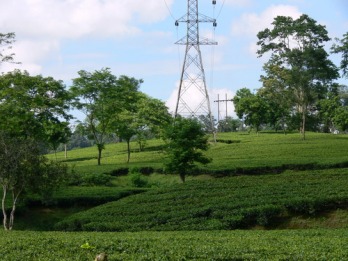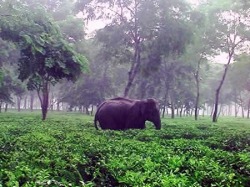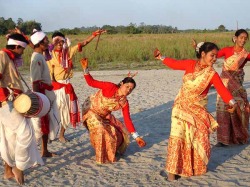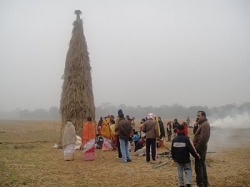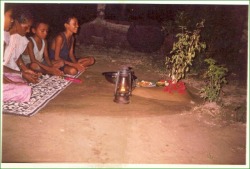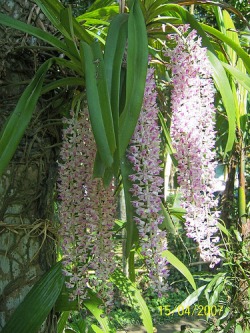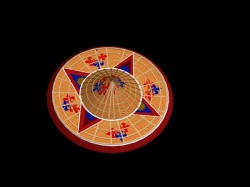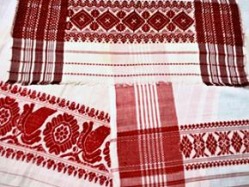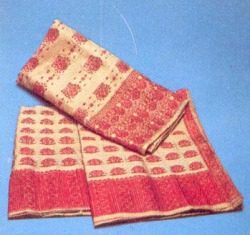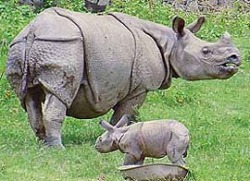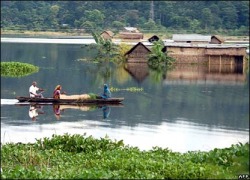ASSAM: A RARELY EXPLORED WORLD OF MIRACLES:
People there call it ‘The Land Of Sunrise’, ‘Land of Green Grass’ and so on and o forth….it is to one of the extreme ends of India linked to the mighty country only through a very narrow passage of land….and that is how this beautiful destination has been tagged as one of the most unexplored and also as a pond of curiosity…..the land of unlimited resources that is being talked about here is ASSAM……and this page is religiously dedicated to an effort of making the land known to everyone who loves nature, adventure and those who are passionate about exploring a rich and extravagant culture that has a rich historical backdrop…….
People there call it ‘The Land Of Sunrise’, ‘Land of Green Grass’ and so on and o forth….it is to one of the extreme ends of India linked to the mighty country only through a very narrow passage of land….and that is how this beautiful destination has been tagged as one of the most unexplored and also as a pond of curiosity…..the land of unlimited resources that is being talked about here is ASSAM……and this page is religiously dedicated to an effort of making the land known to everyone who loves nature, adventure and those who are passionate about exploring a rich and extravagant culture that has a rich historical backdrop…….
HISTORY SAYS...............
Assam has a history that can amuse anyone to the core…Having been ruled by a number of royal families at different point of times since ancient ages, Assam had been witnessing a quite lot of ups and downs to a large extent…yet the land has been strongly standing till date, in fact in the course of this journey the land has learnt to embrace diversity with open hands……And today Assam can be said as a smaller version of India, wherein one can find glimpse of almost all the cultures across the country………..
And that makes this land a land of real BEAUTY…………
Lets look back what the history speaks about Assam…..
Pre-history:
Evidences say that Assam and adjoining regions had been inhibited right from the different periods of the Stone ages. The hills in and around the area, at the height of 1500–2000 feet (460 to 615 m) were popular habitats probably due to availability of exposed dolerite basalt useful for tool-making.
According to the Kalika Purana (17th-18th AD), written in Assam, the earliest ruler of Assam was Mahiranga followed by Hatak, Sambar, Ratna and Ghatak; Naraka removed this line of rulers and established his own Naraka dynasty. It mentions that the last of the Naraka-Bhauma rulers, Narak, was slain by Krishna. Naraka's son Bhagadatta, mentioned in the Mahabharata, fought for the Kauravas in the battle of Kurushetra with an army of kiratas, chinas and dwellers of the eastern coast. Later rulers of Kamarupa frequently drew their lineage from the Naraka rulers.
However, there are lots of evidences to say that Mahayana Buddhism was prominent in ancient Assam. After Huen Shang's visit Mahayana Buddhism came to Assam. Relics of Tezpur, Malini Than, Kamakhya and Madan Kam Dev Temple are the evidences of Mahayana Buddhism.
Ancient and Medieval Assam:
Ancient Assam, known as Kamarupa was ruled by powerful dynasties: the Varmanas (350-650 A.D.), the Salstambhas (655-900 A.D.) and the Kamarupa-Palas (900-1100 A.D.). In the reign of the Varman king, Bhaskaravarman (c.600–650 A.D.), the Chinese traveler Xuan Zang visited the region and recorded his travels. Later, after weakening and disintegration (after the Kamarupa-Palas), the Kamarupa tradition was somewhat extended till 1255 A.D. by the Lunar I (1120-1185 A.D.) and Lunar II (1155-1255 A.D.) dynasties.
Two later dynasties, the Ahoms and the Koch left larger impacts. The Ahoms, a Tai group, ruled Assam for nearly 600 years (1228–1826 A.D.) and the Koch, a Tibeto-Burmese, established sovereignty in c1510 A.D. The Koch kingdom in western Assam and present North Bengal was at its zenith in the early reign of Naranarayana (1540-1587 A.D.). It split into two in 1581 A.D., the western part as a Moghul vassal and the eastern as an Ahom satellite state. Since 13th A.D., the nerve centre of Ahom polity was upper Assam; the kingdom was gradually extended till Karatoya River in the 17th-18th A.D. It was at its zenith during the reign of Sukhrungpha or Sworgodeu Rudra Simha (1696-1714 A.D.). Among other dynasties, the Chutiyas ruled north-eastern Assam and parts of present Arunachal Pradesh and the Kacharis ruled from Dikhow River to central and southern Assam. With expansion of Ahom kingdom, by 1520 A.D. the Chutiya areas were annexed and since c.1536 A.D. Kacharis remained only in Cachar and North Cachar more as an Ahom ally then a competing force. Despite numerous invasions, mostly by the Muslim rulers, no western power ruled Assam until the arrival of the British. The most successful invader Mir Jumla, a governor of Aurangzeb, briefly occupied Garhgaon(c.1662–63 A.D.), the then capital, but found it difficult to control people making guerrilla attacks on his forces, forcing them to leave. The decisive victory of the Assamese led by the great general Lachit Borphukan on theMughals, then under command of Raja Ram Singha at Saraighat (1671) had almost ended Mughal ambitions in this region. Mughals were finally expelled in 1682 A.D. from lower Assam.
British Assam:
Ahom palace intrigue and political turmoil due to the Moamoria rebellion aided the expansionist Burmese ruler of Ava to invade Assam and install a puppet king in 1821. With the Burmese having reached the East India Company’s borders, the First Anglo-Burmese War ensued. The war ended under the Treaty of Yandaboo in 1826, with the Company taking control of Lower Assam and installing Purander Singh as king of Upper Assam in 1833. The arrangement lasted till 1838 and thereafter the British gradually annexed the entire region. Initially Assam was made a part of the Bengal Presidency, then in 1906 it was a part of Eastern Bengal and Assam province, and in 1912 it was reconstituted into a Chief Commissioners' province. In 1913, a Legislative Council and in 1937 the Assam Legislative Assembly was formed in Shillong, the erstwhile capital of the region. The British tea planters imported labour from central India adding to the demographic canvas. After few initial unsuccessful attempts to free Assam during the 1850s, the Assamese since early 20th century joined and actively supported the Indian National Congress against the British. In 1947, Assam including the present Arunachal Pradesh, Nagaland, Mizoram and Meghalaya became a state of the Union of India (princely states, Manipur and Tripura became Group C provinces) and a district of Assam, Sylhet chose to join Pakistan.
Post British
Since 1947, with increasing economic problems in the region, separatist groups began forming along ethnic lines, and demands for autonomy and sovereignty grew, resulting into fragmentation of Assam.
Since the mid-20th century, people from present Bangladesh have been migrating to Assam. In 1961, the Government of Assam passed a legislation making use of Assamese language compulsory. It had to be withdrawn later under pressure from Bengali speaking people in Cachar. In the 1980s the Brahmaputra valley saw a six-year Assam Agitation triggered by the discovery of a sudden rise in registered voters on electoral rolls. It tried to force the government to identify and deport foreigners illegally migrating from neighboring Bangladesh and changing the demographics. The agitation ended after an accord between its leaders and the Union Government, which remained unimplemented, causing simmering discontent.
The post 1970s experienced the growth of armed separatist groups like United Liberation Front of Asom (ULFA) and National Democratic Front of Bodoland (NDFB). In November 1990, the Government of India deployed the Indian army, after which low-intensity military conflicts and political homicides have been continuing for more than a decade. In recent times, ethnicity based militant groups (UPDS,HPDC etc.) have also mushroomed. Regional autonomy has been ensured for Bodos in Bodoland Territorial Council Areas (BTC) and for the Karbis in Karbi Anglong after agitation of the communities due to sluggish rate of development and aspirations for self-government.
And that makes this land a land of real BEAUTY…………
Lets look back what the history speaks about Assam…..
Pre-history:
Evidences say that Assam and adjoining regions had been inhibited right from the different periods of the Stone ages. The hills in and around the area, at the height of 1500–2000 feet (460 to 615 m) were popular habitats probably due to availability of exposed dolerite basalt useful for tool-making.
According to the Kalika Purana (17th-18th AD), written in Assam, the earliest ruler of Assam was Mahiranga followed by Hatak, Sambar, Ratna and Ghatak; Naraka removed this line of rulers and established his own Naraka dynasty. It mentions that the last of the Naraka-Bhauma rulers, Narak, was slain by Krishna. Naraka's son Bhagadatta, mentioned in the Mahabharata, fought for the Kauravas in the battle of Kurushetra with an army of kiratas, chinas and dwellers of the eastern coast. Later rulers of Kamarupa frequently drew their lineage from the Naraka rulers.
However, there are lots of evidences to say that Mahayana Buddhism was prominent in ancient Assam. After Huen Shang's visit Mahayana Buddhism came to Assam. Relics of Tezpur, Malini Than, Kamakhya and Madan Kam Dev Temple are the evidences of Mahayana Buddhism.
Ancient and Medieval Assam:
Ancient Assam, known as Kamarupa was ruled by powerful dynasties: the Varmanas (350-650 A.D.), the Salstambhas (655-900 A.D.) and the Kamarupa-Palas (900-1100 A.D.). In the reign of the Varman king, Bhaskaravarman (c.600–650 A.D.), the Chinese traveler Xuan Zang visited the region and recorded his travels. Later, after weakening and disintegration (after the Kamarupa-Palas), the Kamarupa tradition was somewhat extended till 1255 A.D. by the Lunar I (1120-1185 A.D.) and Lunar II (1155-1255 A.D.) dynasties.
Two later dynasties, the Ahoms and the Koch left larger impacts. The Ahoms, a Tai group, ruled Assam for nearly 600 years (1228–1826 A.D.) and the Koch, a Tibeto-Burmese, established sovereignty in c1510 A.D. The Koch kingdom in western Assam and present North Bengal was at its zenith in the early reign of Naranarayana (1540-1587 A.D.). It split into two in 1581 A.D., the western part as a Moghul vassal and the eastern as an Ahom satellite state. Since 13th A.D., the nerve centre of Ahom polity was upper Assam; the kingdom was gradually extended till Karatoya River in the 17th-18th A.D. It was at its zenith during the reign of Sukhrungpha or Sworgodeu Rudra Simha (1696-1714 A.D.). Among other dynasties, the Chutiyas ruled north-eastern Assam and parts of present Arunachal Pradesh and the Kacharis ruled from Dikhow River to central and southern Assam. With expansion of Ahom kingdom, by 1520 A.D. the Chutiya areas were annexed and since c.1536 A.D. Kacharis remained only in Cachar and North Cachar more as an Ahom ally then a competing force. Despite numerous invasions, mostly by the Muslim rulers, no western power ruled Assam until the arrival of the British. The most successful invader Mir Jumla, a governor of Aurangzeb, briefly occupied Garhgaon(c.1662–63 A.D.), the then capital, but found it difficult to control people making guerrilla attacks on his forces, forcing them to leave. The decisive victory of the Assamese led by the great general Lachit Borphukan on theMughals, then under command of Raja Ram Singha at Saraighat (1671) had almost ended Mughal ambitions in this region. Mughals were finally expelled in 1682 A.D. from lower Assam.
British Assam:
Ahom palace intrigue and political turmoil due to the Moamoria rebellion aided the expansionist Burmese ruler of Ava to invade Assam and install a puppet king in 1821. With the Burmese having reached the East India Company’s borders, the First Anglo-Burmese War ensued. The war ended under the Treaty of Yandaboo in 1826, with the Company taking control of Lower Assam and installing Purander Singh as king of Upper Assam in 1833. The arrangement lasted till 1838 and thereafter the British gradually annexed the entire region. Initially Assam was made a part of the Bengal Presidency, then in 1906 it was a part of Eastern Bengal and Assam province, and in 1912 it was reconstituted into a Chief Commissioners' province. In 1913, a Legislative Council and in 1937 the Assam Legislative Assembly was formed in Shillong, the erstwhile capital of the region. The British tea planters imported labour from central India adding to the demographic canvas. After few initial unsuccessful attempts to free Assam during the 1850s, the Assamese since early 20th century joined and actively supported the Indian National Congress against the British. In 1947, Assam including the present Arunachal Pradesh, Nagaland, Mizoram and Meghalaya became a state of the Union of India (princely states, Manipur and Tripura became Group C provinces) and a district of Assam, Sylhet chose to join Pakistan.
Post British
Since 1947, with increasing economic problems in the region, separatist groups began forming along ethnic lines, and demands for autonomy and sovereignty grew, resulting into fragmentation of Assam.
Since the mid-20th century, people from present Bangladesh have been migrating to Assam. In 1961, the Government of Assam passed a legislation making use of Assamese language compulsory. It had to be withdrawn later under pressure from Bengali speaking people in Cachar. In the 1980s the Brahmaputra valley saw a six-year Assam Agitation triggered by the discovery of a sudden rise in registered voters on electoral rolls. It tried to force the government to identify and deport foreigners illegally migrating from neighboring Bangladesh and changing the demographics. The agitation ended after an accord between its leaders and the Union Government, which remained unimplemented, causing simmering discontent.
The post 1970s experienced the growth of armed separatist groups like United Liberation Front of Asom (ULFA) and National Democratic Front of Bodoland (NDFB). In November 1990, the Government of India deployed the Indian army, after which low-intensity military conflicts and political homicides have been continuing for more than a decade. In recent times, ethnicity based militant groups (UPDS,HPDC etc.) have also mushroomed. Regional autonomy has been ensured for Bodos in Bodoland Territorial Council Areas (BTC) and for the Karbis in Karbi Anglong after agitation of the communities due to sluggish rate of development and aspirations for self-government.
ASSAM IS FAMOUS FOR............
1. TEA:
Tea, scientifically known as Camellia sinensis was discovered in Assam in 1834. Followed by its tests in 1836-37 in London, the British allowed companies to rent land in Assam to produce it from 1839. Thereafter tea plantations started in a large scale in Upper Assam, where the soil and the climate were most suitable. Problems with the imported laborers from China and hostilities of native Assamese resulted into migration of forced laborers from central-eastern parts of India. After initial trial and error with planting the Chinese and the Assamese-Chinese hybrid varieties, the planters later accepted the local tea, Camellia assamica as the most suitable one for Assam. By 1850s, the industry started seeing some profits and saw its initial growth, when in 1861, investors were allowed to own land in Assam. It started seeing substantial progress with invention of new technologies and machinery for preparing processed tea during 1870s. The cost of Assam tea was lowered down manifold and became more competitive than its Chinese variant. In 1888, the tea growers in Assam formed The Indian Tea Association to lobby to retain the status quo and the organization was very successful in this.
Assam tea is generally harvested twice, in a “first flush” and a “second flush.” The first flush is picked during late March. The second flush, harvested later, is the more prized “tippy tea,” named thus for the gold tips that appear on the leaves. This second flush, tippy tea, is sweeter and more full-bodied and is generally considered superior to the first flush tea. The leaves of the Assam tea bush are dark green and glossy and fairly wide compared to those of the Chinese tea plant. The bush produces delicate white blossoms.
Assam is one of the most prolific tea-producing regions in the world. Each year, the tea estates of Assam collectively yield approximately 1.5 million pounds (680,400 kg) of tea.
Almost 45% of India's total production of tea is from Assam.
Tea, scientifically known as Camellia sinensis was discovered in Assam in 1834. Followed by its tests in 1836-37 in London, the British allowed companies to rent land in Assam to produce it from 1839. Thereafter tea plantations started in a large scale in Upper Assam, where the soil and the climate were most suitable. Problems with the imported laborers from China and hostilities of native Assamese resulted into migration of forced laborers from central-eastern parts of India. After initial trial and error with planting the Chinese and the Assamese-Chinese hybrid varieties, the planters later accepted the local tea, Camellia assamica as the most suitable one for Assam. By 1850s, the industry started seeing some profits and saw its initial growth, when in 1861, investors were allowed to own land in Assam. It started seeing substantial progress with invention of new technologies and machinery for preparing processed tea during 1870s. The cost of Assam tea was lowered down manifold and became more competitive than its Chinese variant. In 1888, the tea growers in Assam formed The Indian Tea Association to lobby to retain the status quo and the organization was very successful in this.
Assam tea is generally harvested twice, in a “first flush” and a “second flush.” The first flush is picked during late March. The second flush, harvested later, is the more prized “tippy tea,” named thus for the gold tips that appear on the leaves. This second flush, tippy tea, is sweeter and more full-bodied and is generally considered superior to the first flush tea. The leaves of the Assam tea bush are dark green and glossy and fairly wide compared to those of the Chinese tea plant. The bush produces delicate white blossoms.
Assam is one of the most prolific tea-producing regions in the world. Each year, the tea estates of Assam collectively yield approximately 1.5 million pounds (680,400 kg) of tea.
Almost 45% of India's total production of tea is from Assam.
2. BIHU:
Origin of Bihu:
Bihu is said to have its origin in the pre-Aryan days around 3500 BC. The festival of Bihu is celebrated almost for month, although todays busy work culture leave scope to celebrate it only for a week. A no holds barred dancing session is the most intriguing part of the festival and symbolises the fertility rites of the original inhabitants of the hilly regions of the northeast in India. The farmers fancied that the erotic content of the songs would sexually arouse the earth’s body, leading to an abundant harvest. There are 3 bihus celebrated during 3 specific time period of the year.
Bohag Bihu:
This falls on the New Year’s Day of the Assamese calendar. According to the solar calendar that the Assamese follow, the New Year usually falls on 14th April. During the first week of this month Assam celebrates Bohag Bihu to welcome the new year with a huge lot of passion and hope. This passion reflects in the extravagant ways how people in the land go about the celebration. The exotic style in which Assamese dress up for the bihu dance in this duration is one of the most attractive features of the festival. Also the climatic condition and the natural elements add colors to the festival in their own way. It is one of the most pleasant times in the region and a lot of known unknown flowers spread their fragrances in the season. A large variety of orchids, popularly known as Kopouful symbolizes the festivity in the air, which are also used as ornaments on hair by the beautiful female dancers in bihu dances.
The first day of Bohag bihu is known as Gorur bihu, also called Uruka which falls on the day of Sankranti and is devoted to the cow. Since cow is considered to be a sacred animal and given respect as Mother in India, this very day is reserved for the worshipping and caring of this animal. Care is showered on cows on this day, starting with bathing them in the pond. The horns and hooves are brushed with whisks made from Deeghloti or Makheatr (lilsoca salocrfolea). A mixture of twigs, turmeric and moong dal (pulses) that acts as a disinfectant,is applied as a paste on them,gourd and brinjal are fed to the cows after which their foreheads are marked with vermilion. As the night falls, the tired but satiated cows are led back to their sheds and thoroughly cleansed. Only then does the household sit down for a sumptuous meal of assorted preparations of chirwa (flat rice) and a mind-boggling array of sweets.
The following day is welcomed as Manuhor bihu or the bihu of human beings. The Assamese celebrate their New Year on this day. A lavish feast is organized for the day and married daughters along with other relatives are invited for the same. On this day, delicacies such as Pitha (made from rice and coconut), Laddoo (made from shredded coconut) and Til laddoo (made from sesame seed) are prepared. Gamacha, which is considered one of the many symbols of the festival, are presented to everyone by the ladies of the house, who look graceful in their new Mekhela Chadar, woven with the golden-coloured muga silk that is indigenous to Assam. Accessories like Gumkham bracelets made from an alloy of silver and gold nuggets found in the rivers give the ladies a complete look.
Kaati Bihu:
The second bihu named Kaati bihu or Kangali bihu is held in the month of kartik (September or October). But there is a lot of difference in the celebration of this bihu from tha of Bohag bihu. This is a celebration which is meant for the worship of the deities for a rich harvest. Predictably enough, this bihu is dedicated to the worship of none other than Goddess Lakshmi who is the dispenser of wealth to mortals. As night falls, lamps are lit in the paddy fields where farmers have toiled through the day. At the end of a hard day’s work, all the members of a family pray to the benign Goddess for the well-being of their crop and cattle. Tulsi (Basil) tree, which is considered very sacred in Hindusm is planted or pruned in the courtyard of each household, Earthen lamps are lit next to it and Puja is performed. This continues for the rest of the year.
Magh Bihu:
The Magh bihu that generally falls on 14th January,which is on the Sankranti of the month, is the third bihu that calls for a grand celebration in Assamese homes. This is again a joyous occasion as the granaries are stocked with the recently harvested crops. Seven days of non-stop fun and frolic mark this festival. But the best thing about this bihu is the elaborate and sumptious cuisine that is prepared. This grand feast known as bhog is held on the night of the first day of the festival that is also called Uruka.
Origin of Bihu:
Bihu is said to have its origin in the pre-Aryan days around 3500 BC. The festival of Bihu is celebrated almost for month, although todays busy work culture leave scope to celebrate it only for a week. A no holds barred dancing session is the most intriguing part of the festival and symbolises the fertility rites of the original inhabitants of the hilly regions of the northeast in India. The farmers fancied that the erotic content of the songs would sexually arouse the earth’s body, leading to an abundant harvest. There are 3 bihus celebrated during 3 specific time period of the year.
Bohag Bihu:
This falls on the New Year’s Day of the Assamese calendar. According to the solar calendar that the Assamese follow, the New Year usually falls on 14th April. During the first week of this month Assam celebrates Bohag Bihu to welcome the new year with a huge lot of passion and hope. This passion reflects in the extravagant ways how people in the land go about the celebration. The exotic style in which Assamese dress up for the bihu dance in this duration is one of the most attractive features of the festival. Also the climatic condition and the natural elements add colors to the festival in their own way. It is one of the most pleasant times in the region and a lot of known unknown flowers spread their fragrances in the season. A large variety of orchids, popularly known as Kopouful symbolizes the festivity in the air, which are also used as ornaments on hair by the beautiful female dancers in bihu dances.
The first day of Bohag bihu is known as Gorur bihu, also called Uruka which falls on the day of Sankranti and is devoted to the cow. Since cow is considered to be a sacred animal and given respect as Mother in India, this very day is reserved for the worshipping and caring of this animal. Care is showered on cows on this day, starting with bathing them in the pond. The horns and hooves are brushed with whisks made from Deeghloti or Makheatr (lilsoca salocrfolea). A mixture of twigs, turmeric and moong dal (pulses) that acts as a disinfectant,is applied as a paste on them,gourd and brinjal are fed to the cows after which their foreheads are marked with vermilion. As the night falls, the tired but satiated cows are led back to their sheds and thoroughly cleansed. Only then does the household sit down for a sumptuous meal of assorted preparations of chirwa (flat rice) and a mind-boggling array of sweets.
The following day is welcomed as Manuhor bihu or the bihu of human beings. The Assamese celebrate their New Year on this day. A lavish feast is organized for the day and married daughters along with other relatives are invited for the same. On this day, delicacies such as Pitha (made from rice and coconut), Laddoo (made from shredded coconut) and Til laddoo (made from sesame seed) are prepared. Gamacha, which is considered one of the many symbols of the festival, are presented to everyone by the ladies of the house, who look graceful in their new Mekhela Chadar, woven with the golden-coloured muga silk that is indigenous to Assam. Accessories like Gumkham bracelets made from an alloy of silver and gold nuggets found in the rivers give the ladies a complete look.
Kaati Bihu:
The second bihu named Kaati bihu or Kangali bihu is held in the month of kartik (September or October). But there is a lot of difference in the celebration of this bihu from tha of Bohag bihu. This is a celebration which is meant for the worship of the deities for a rich harvest. Predictably enough, this bihu is dedicated to the worship of none other than Goddess Lakshmi who is the dispenser of wealth to mortals. As night falls, lamps are lit in the paddy fields where farmers have toiled through the day. At the end of a hard day’s work, all the members of a family pray to the benign Goddess for the well-being of their crop and cattle. Tulsi (Basil) tree, which is considered very sacred in Hindusm is planted or pruned in the courtyard of each household, Earthen lamps are lit next to it and Puja is performed. This continues for the rest of the year.
Magh Bihu:
The Magh bihu that generally falls on 14th January,which is on the Sankranti of the month, is the third bihu that calls for a grand celebration in Assamese homes. This is again a joyous occasion as the granaries are stocked with the recently harvested crops. Seven days of non-stop fun and frolic mark this festival. But the best thing about this bihu is the elaborate and sumptious cuisine that is prepared. This grand feast known as bhog is held on the night of the first day of the festival that is also called Uruka.
3. NATIONAL PARKS IN ASSAM:
A. Kaziranga National Park
B. Manas National Park
C. Orang National Park
D. Dibru Chaikhowa National Park
E. Nameri National Park
Kaziranga National Park:
Kaziranga National Park lies on the banks of the mighty Brahmaputra River, Kaziranga National Park covers an area of approximately 430 Sq. kms with its swamps and tall thickets of elephant grass making it the ideal habitat for the Indian one-horned. The vast open country makes Kaziranga very accessible and wildlife viewing fairly pleasurable. Here one can leave in the early hours of the dawn for an elephant-back-ride. One could see wild elephant herds roaming around or rhinos browse past visitors unconcernedly. Since Kaziranga is easily accessible, it provides a chance to see animals in the wild at close quarters, thus making a trip to this National Park a very rewarding experience. The Park lies in the flood plains of the Brahmaputra River. The Kabri Angling Hill ranges rise around the park pressing it against the Brahmaputra River, flowing as its northern boundary. Into the soup plate between the river and the ranges, flow several rivulets. The Kabri Angling Hill ranges rise around the park pressing it against the Brahmaputra River, flowing as its northern boundary. Into the soup plate between the river and the ranges, flow several rivulets. They bring down rich silt and sand, spread in small lakes, silt up the lakes to make swamp and marshes, alluvial grasslands rising to alluvial Savannah woodlands; and then as the land loses its moisture with height, rise to mixed deciduous forests and finally, to tropical evergreen forests. It is believed that if nature had not designed such a breathtakingly beautiful habitat, it would have been extremely difficult for man to create a national park with such natural diversities suited to a diverse range of animal species. Kaziranga National Park is the stronghold of the one horned rhinoceros. There are over 1000 rhinos in this reserve. The wild elephant, another exotic animal of the region and often-found in herds number over 700 here. The wild buffalo is another attraction of the reserve and again there are over 6oo of these in the reserve. The mouse deer, the hog deer, barking deer, chinkara gazelle, bears, leopards, leopard cat, wild boars and the gaur are to be found here besides a variety of the primate family. The bird life of Kaziranga National Park is typical of the north-eastern Foothill of India. The highlight of the bird life here are the sights of hundreds and hundreds of Pelicans, which breed here. The other birds commonly found here are Crested Serpent eagle, Pallas fishing eagle, grey - headed fishing eagle, swamp partridges, red jungle fowl, Bengal florican, bar headed goose, whistling teal, egrets, herons, black - necked stork, and open billed stork.
Wildlife Attarction in Kaziranga:Indian Rhino:
The Indian rhino properly know as the Great Indian One Horned Rhinoceros is a desendant of an old species of rhino. Despite of its fearsome apperance, it is generall a peaceful animal. It is one of the two greatest success stories in rhino conservation (the other one being the Southern White Rhino in South Africa).
A. Kaziranga National Park
B. Manas National Park
C. Orang National Park
D. Dibru Chaikhowa National Park
E. Nameri National Park
Kaziranga National Park:
Kaziranga National Park lies on the banks of the mighty Brahmaputra River, Kaziranga National Park covers an area of approximately 430 Sq. kms with its swamps and tall thickets of elephant grass making it the ideal habitat for the Indian one-horned. The vast open country makes Kaziranga very accessible and wildlife viewing fairly pleasurable. Here one can leave in the early hours of the dawn for an elephant-back-ride. One could see wild elephant herds roaming around or rhinos browse past visitors unconcernedly. Since Kaziranga is easily accessible, it provides a chance to see animals in the wild at close quarters, thus making a trip to this National Park a very rewarding experience. The Park lies in the flood plains of the Brahmaputra River. The Kabri Angling Hill ranges rise around the park pressing it against the Brahmaputra River, flowing as its northern boundary. Into the soup plate between the river and the ranges, flow several rivulets. The Kabri Angling Hill ranges rise around the park pressing it against the Brahmaputra River, flowing as its northern boundary. Into the soup plate between the river and the ranges, flow several rivulets. They bring down rich silt and sand, spread in small lakes, silt up the lakes to make swamp and marshes, alluvial grasslands rising to alluvial Savannah woodlands; and then as the land loses its moisture with height, rise to mixed deciduous forests and finally, to tropical evergreen forests. It is believed that if nature had not designed such a breathtakingly beautiful habitat, it would have been extremely difficult for man to create a national park with such natural diversities suited to a diverse range of animal species. Kaziranga National Park is the stronghold of the one horned rhinoceros. There are over 1000 rhinos in this reserve. The wild elephant, another exotic animal of the region and often-found in herds number over 700 here. The wild buffalo is another attraction of the reserve and again there are over 6oo of these in the reserve. The mouse deer, the hog deer, barking deer, chinkara gazelle, bears, leopards, leopard cat, wild boars and the gaur are to be found here besides a variety of the primate family. The bird life of Kaziranga National Park is typical of the north-eastern Foothill of India. The highlight of the bird life here are the sights of hundreds and hundreds of Pelicans, which breed here. The other birds commonly found here are Crested Serpent eagle, Pallas fishing eagle, grey - headed fishing eagle, swamp partridges, red jungle fowl, Bengal florican, bar headed goose, whistling teal, egrets, herons, black - necked stork, and open billed stork.
Wildlife Attarction in Kaziranga:Indian Rhino:
The Indian rhino properly know as the Great Indian One Horned Rhinoceros is a desendant of an old species of rhino. Despite of its fearsome apperance, it is generall a peaceful animal. It is one of the two greatest success stories in rhino conservation (the other one being the Southern White Rhino in South Africa).



